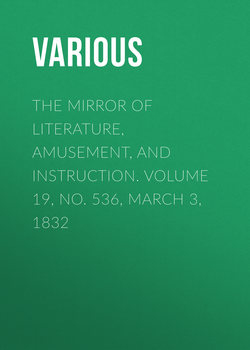Читать книгу The Mirror of Literature, Amusement, and Instruction. Volume 19, No. 536, March 3, 1832 - Various - Страница 3
OUR LADY'S CHAPEL, SOUTHWARK
ОглавлениеIt may not plainly appear to some readers that our Engraving of this fine vestige of ancient art, is from a View taken in the year 1818. The Bishop's Chapel, which is there shown, was demolished about twelve months since, at whose bidding we know not; perhaps of the same party who now contend for the destruction of the Lady Chapel.
By the way we referred to the Altar Screen, of which we now find the following memorandum in a History of St. Saviour's Church, published in 1795:4
"Anno 1618. 15 Jac. I. "The screen at the entrance to the chapel of the Virgin Mary was this year set up."
In the same work occur the particulars of the repairs of the Lady Chapel in 1624:
"Anno 1624. 21 Jac. I. "The chapel of the Virgin Mary was restored to the parishioners, being let out to bakers for above sixty years before, and 200l. laid out in the repair. Of which we preserve the following extract from Stowe:
"But passing all these, some what now of that part of this church above the chancell, that in former times was called Our Ladies Chappell.
"It is now called the New Chappell; and indeed, though very old, it now may be called a new one, because newly redeemed from such use and imployment, as in respect of that it was built to, divine and religious duties, may very well be branded, with the style of wretched, base, and unworthy, for that, that before this abuse, was (and is now) a faire and beautifull chappell, by those that were then the corporation (which is a body consisting of thirty vestry-men, six of those thirty, churchwardens) was leased and let out, and the house of God made a bake-house.
"Two very faire doores, that from the two side iles of the chancell of this church, and two that thorow the head of the chancell (as at this day they doe againe) went into it, were lath't, daub'd, and dam'd up: the faire pillars were ordinary posts against which they piled billets and bavens: in this place they had their ovens, in that a bolting place, in that their kneading trough, in another (I have heard) a hogs-trough; for the words that were given mee were these, this place have I knowne a hog-stie, in another a store house, to store up their hoorded meal; and in all of it something of this sordid kind and condition. It was first let by the corporation afore named, to one Wyat, after him, to one Peacocke, after him, to one Cleybrooke, and last, to one Wilson, all bakers, and this chappell still imployed in the way of their trade, a bake-house, though some part of this bake-house was some time turned into a starch-house.
"The time of the continuance of it in this kind, from the first letting of it to Wyat, to the restoring of it again to the church, was threescore and some odde yeeres, in the yeere of our Lord God 1624, for in this yeere the ruines and blasted estate, that the old corporation sold it to, were by the corporation of this time, repaired, renewed, well, and very worthily beautified: the charge of it for that yeere, with many things done to it since, arising to two hundred pounds.
"This, as all the former repairs, being the sole cost and charge of the parishioners."
A correspondent, E.E. inquires how it happens that the Chapel of St. Mary Magdalen, shown in all old plans of the Church, has likewise disappeared within the present century? This Chapel adjoined the South transept, and was removed during the repairs, under the able superintendence of Mr. Gwilt. It was thus described by Mr. Nightingale in 1818:
"The chapel itself is a very plain erection. It is entered on the south, through a large pair of folding doors, leading down a small flight of steps. The ceiling has nothing peculiar in its character; nor are the four pillars supporting the roof, and the unequal arches leading into the south aisle, in the least calculated to convey any idea of grandeur, or feeling of veneration. These arches have been cut through in a very clumsy manner, so that scarcely any vestige of the ancient church of St. Mary Magdalen now remains. A small doorway and windows, however, are still visible at the east end of this chapel; the west end formerly opened into the south transept; but that also is now walled up, except a part, which leads to the gallery there. There are in different parts niches which once held the holy water, by which the pious devotees of former ages sprinkled their foreheads on their entrance before the altar, I am not aware that any other remains of the old church are now visible in this chapel. Passing through the eastern end of the south aisle, a pair of gates leads into the Virgin Mary's Chapel."
From what we remember of the character of this Chapel, the lovers of architecture have little to lament in its removal. Our Correspondent, E.E., adds—"This, and not the Lady Chapel, it was, (No. 456 of The Mirror,) that contained the gravestone of one Bishop Wickham, who, however, was not the famous builder of Windsor Castle, in the time of Edward III., but died in 1595, the same year in which he was translated from the see of Lincoln to that of Winchester. His gravestone, now lying exposed in the churchyard, marks the south-east corner of the site of the aforesaid Magdalen Chapel."
4
By M.M. Concanen, jun. and A. Morgan.
